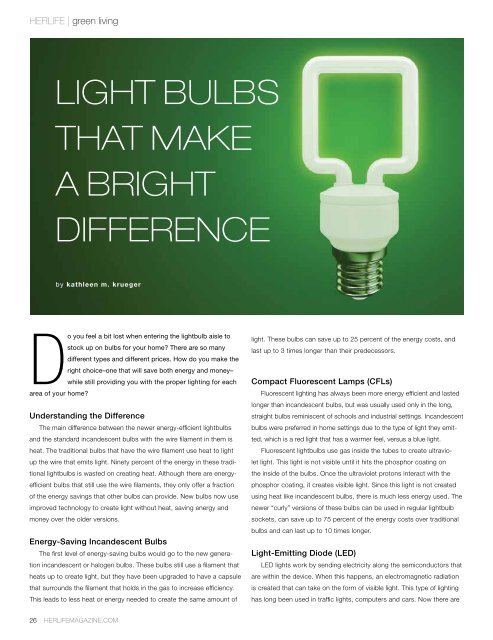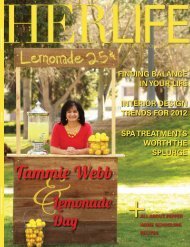TARA BATTIATO - HERLIFE Magazine
TARA BATTIATO - HERLIFE Magazine
TARA BATTIATO - HERLIFE Magazine
Create successful ePaper yourself
Turn your PDF publications into a flip-book with our unique Google optimized e-Paper software.
herlife | green living<br />
Light Bulbs<br />
That Make<br />
a Bright<br />
Difference<br />
by kathleen m. krueger<br />
Do you feel a bit lost when entering the lightbulb aisle to<br />
stock up on bulbs for your home? There are so many<br />
different types and different prices. How do you make the<br />
right choice–one that will save both energy and money–<br />
while still providing you with the proper lighting for each<br />
area of your home?<br />
Understanding the Difference<br />
The main difference between the newer energy-efficient lightbulbs<br />
and the standard incandescent bulbs with the wire filament in them is<br />
heat. The traditional bulbs that have the wire filament use heat to light<br />
up the wire that emits light. Ninety percent of the energy in these traditional<br />
lightbulbs is wasted on creating heat. Although there are energyefficient<br />
bulbs that still use the wire filaments, they only offer a fraction<br />
of the energy savings that other bulbs can provide. New bulbs now use<br />
improved technology to create light without heat, saving energy and<br />
money over the older versions.<br />
Energy-Saving Incandescent Bulbs<br />
The first level of energy-saving bulbs would go to the new generation<br />
incandescent or halogen bulbs. These bulbs still use a filament that<br />
heats up to create light, but they have been upgraded to have a capsule<br />
that surrounds the filament that holds in the gas to increase efficiency.<br />
This leads to less heat or energy needed to create the same amount of<br />
light. These bulbs can save up to 25 percent of the energy costs, and<br />
last up to 3 times longer than their predecessors.<br />
Compact Fluorescent Lamps (CFLs)<br />
Fluorescent lighting has always been more energy efficient and lasted<br />
longer than incandescent bulbs, but was usually used only in the long,<br />
straight bulbs reminiscent of schools and industrial settings. Incandescent<br />
bulbs were preferred in home settings due to the type of light they emitted,<br />
which is a red light that has a warmer feel, versus a blue light.<br />
Fluorescent lightbulbs use gas inside the tubes to create ultraviolet<br />
light. This light is not visible until it hits the phosphor coating on<br />
the inside of the bulbs. Once the ultraviolet protons interact with the<br />
phosphor coating, it creates visible light. Since this light is not created<br />
using heat like incandescent bulbs, there is much less energy used. The<br />
newer “curly” versions of these bulbs can be used in regular lightbulb<br />
sockets, can save up to 75 percent of the energy costs over traditional<br />
bulbs and can last up to 10 times longer.<br />
Light-Emitting Diode (LED)<br />
LED lights work by sending electricity along the semiconductors that<br />
are within the device. When this happens, an electromagnetic radiation<br />
is created that can take on the form of visible light. This type of lighting<br />
has long been used in traffic lights, computers and cars. Now there are<br />
26 <strong>HERLIFE</strong>MAGAZINE.COM

















